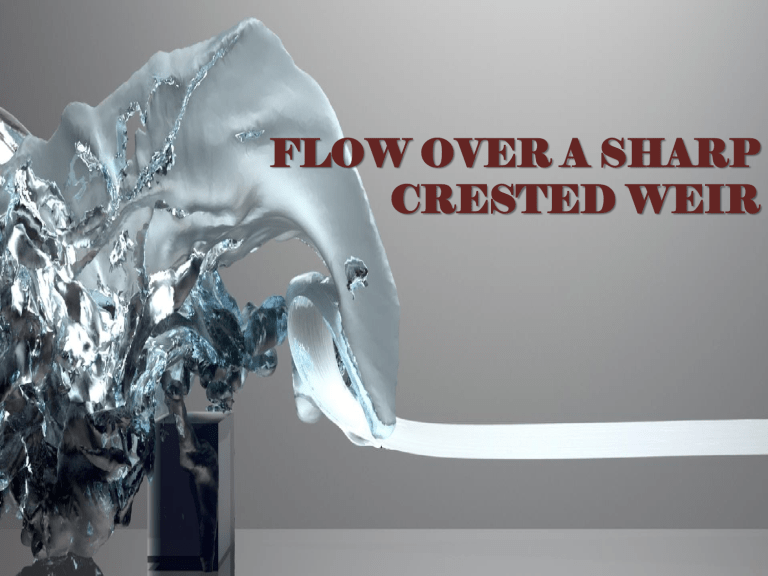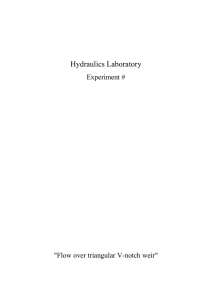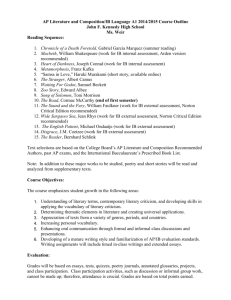
FLOW OVER A SHARP CRESTED WEIR Chittagong University of Engineering and Technology Dept. of Civil Engineering GROUP-B1(4) ID:1601084 1601085 1601086 1601087 1601088 TABLE OF CONTENTS 1.Introduction 2.Theory 3.Procedure 4.Calculation 5.Result 6.Discussion 7.Application Introduction A weir with a sharp upstream corner or edge such that the water springs clear of the crest is a sharp-crested weir. It is commonly used in large scale situations. For small scale applications, weirs are often referred to as notches and invariably are sharp edged. THEORY In a sharp-crested weir, the thickness of the weir is kept less than half of the height of water on the weir, i.e; b<H/2 where, b=Thickness of the weir. H=Height of water above the crest of the weir. The discharge equation for a sharp-crested weir, remains the same as that of rectangular weir & rectangular notch, i.e; Q= 𝟐 𝟑 𝐂𝐝 × 𝐛 𝟐𝐠 × 𝐇 where, 𝑪𝒅 =Co-efficient of discharge. 𝟑 𝟐 PROCEDURE At first, the pump was started & to get the uniform flow 4-5 minutes were needed. Then the bench was adjusted regulating the valve to give the first required head level of approximately 10mm. Collected data was used to plot graphs. Time was counted through a stop watch till water reaches the required level. The pressure head was observed after that. Depth of water level was fixed. CALCULATION Depth of water, dw = (110-30)mm=8cm Volume of water = (45×30.5×8) cm3 = 10980 cm3 Time to fill, T= 18.1 sec 𝐕𝐨𝐥𝐮𝐦𝐞 Actual Discharge, Qa = 𝐓𝐢𝐦𝐞 𝟏𝟎𝟗𝟖𝟎 = cm3/sec 𝟏𝟖.𝟏 = 606.63 cm3/sec 𝐂𝐨𝐞𝐟𝐟𝐢𝐜𝐢𝐞𝐧𝐭 𝐨𝐟 𝐝𝐢𝐬𝐜𝐡𝐚𝐫𝐠𝐞, 𝐂𝐝 = Pressure head, H = (37-10)mm = 27mm = 2.7 cm Thickness of the weir, b = 7.5 cm Theoretical Discharge, 𝐐𝐭 = 𝟐 = 𝟑 𝟐 𝟑 × 𝒃 𝟐𝒈 × 𝑯 𝟑 𝟐 × 𝟕. 𝟓 × 𝟐 × 𝟗𝟖𝟏 (𝟐. 𝟕) cm3/sec = 982.57 cm3/sec 𝐐𝐚 𝐐𝐭 𝟑 𝟐 = 𝟔𝟎𝟔.𝟔𝟑 𝟗𝟖𝟐.𝟓𝟕 = 𝟎. 𝟔𝟐 RESULT Qa Vs H Graph 800 1000 Qa (Actual Discharge in cm3/sec) Qa (Actual Discharge in cm3/sec) Qa Vs Qt Graph 700 600 500 y = 0.618x 400 300 200 100 0 100 10 0 200 400 600 800 1000 Qt (Theoretical Discharge in 1200 cm3/sec 1400 1 10 Pressure Head,H(cm) The co-efficient of discharge from graph, Cd = 0.62 The co-efficient of discharge from calculation, Cd = 0.61 The exponent of H = 1.45 100 DISCUSSION The experiment has been done very carefully. We have found the Cd 0.62 and the exponent of H 1.45 where the standard value of these are 0.65 and 1.50 respectively. Though maximum precautions were maintained, some errors have been occurred. The meniscus reading was not found accurately as it was not hold in a stable position. There was some shakings and vibrations which might have affected the value. The apparatus is old, so there may have some mechanical errors and the fluid flow was not fully uniform. Also there was some inaccuracy in recording time in the stopwatch (human error) and plotting the points in the log paper was also not hundred percent accurate. All these factors together contributed to the error for which the ideal value could not be found rather a value quite near to the ideal value was calculated. APPLICATION The data gained from flow rate calculations over a rectangular sharp-crested weir can be used in a number of ways: Flood control and general water management policies are often designed on the basis of such data. The data can be used to determine if a hydroelectric project would be possible or profitable. It can also be useful for environmental impact studies, specifically in determining how the weir would affect the ecosystem of a stream or river. Irrigation is also benefited from this kind of data. THANK YOU


